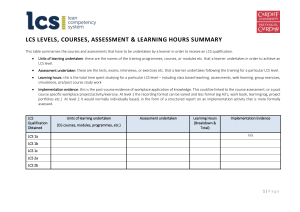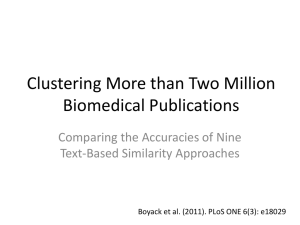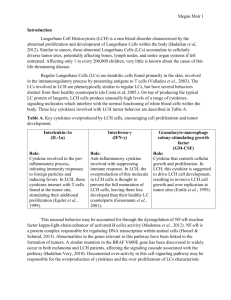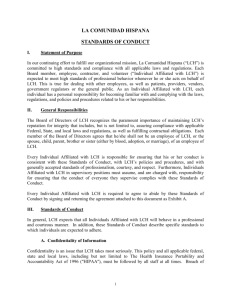YTEX Semantic Similarity Measures
advertisement
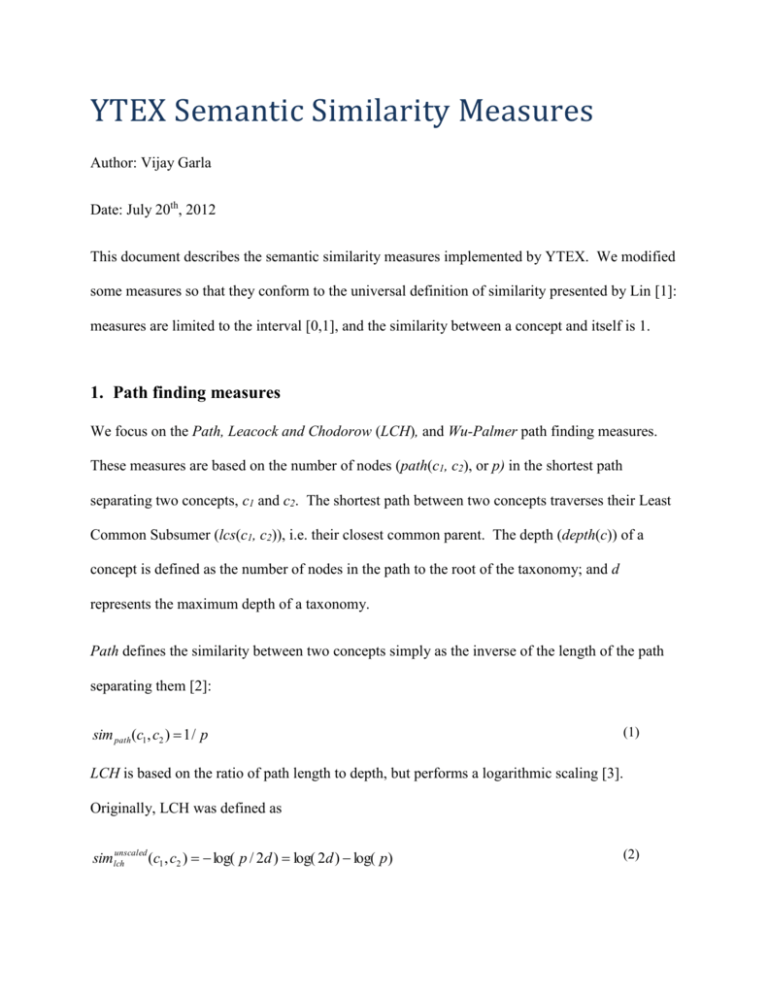
YTEX Semantic Similarity Measures Author: Vijay Garla Date: July 20th, 2012 This document describes the semantic similarity measures implemented by YTEX. We modified some measures so that they conform to the universal definition of similarity presented by Lin [1]: measures are limited to the interval [0,1], and the similarity between a concept and itself is 1. 1. Path finding measures We focus on the Path, Leacock and Chodorow (LCH), and Wu-Palmer path finding measures. These measures are based on the number of nodes (path(c1, c2), or p) in the shortest path separating two concepts, c1 and c2. The shortest path between two concepts traverses their Least Common Subsumer (lcs(c1, c2)), i.e. their closest common parent. The depth (depth(c)) of a concept is defined as the number of nodes in the path to the root of the taxonomy; and d represents the maximum depth of a taxonomy. Path defines the similarity between two concepts simply as the inverse of the length of the path separating them [2]: sim path (c1 , c2 ) 1 / p (1) LCH is based on the ratio of path length to depth, but performs a logarithmic scaling [3]. Originally, LCH was defined as unscaled simlch (c1 , c2 ) log( p / 2d ) log( 2d ) log( p) (2) where d represents the maximum depth of the taxonomy. As proposed in [4], we scale LCH to the unit interval by dividing by log(2d). Dividing by a constant value has no effect on the spearman correlation with benchmarks: the relative ranks of concept pair similarities remain the same. simlch (c1 , c2 ) 1 log( p) log( 2 d ) (3) Wu & Palmer scales the depth of the LCS by the length of the path between two concepts [4]: sim unscaled (c1 , c2 ) wp 2 depth(lcs (c1 , c2 )) path(c1 , lcs (c1 , c2 )) path(c2 , lcs (c1 , c2 )) 2 depth(lcs (c1 , c2 )) (4) One problem with this definition is that the similarity of a concept with itself is less than 1 (if c1 = c2, then path(c1, lcs (c1, c2 )) path(c2 , lcs (c1, c2 )) 2 ). Instead, we adopt the definition of Wu & Palmer used in the Natural Language Toolkit [5]: sim wp (c1 , c2 ) 2 depth(lcs (c1 , c2 )) p 1 2 depth(lcs (c1 , c2 )) (5) Under this definition, if c1 = c2, then p-1 = 0, and the similarity measure evaluates to 1. 2. IC based measures Information content can be estimated solely from the structure of a taxonomy (intrinsic IC), or from the distribution of concepts in a text corpus in conjunction with a taxonomy (corpus IC) [6– 8]. The corpus IC (ICcorpus(c)) of a concept is defined as the inverse of the log of the concept’s frequency [6]. The frequency of a concept is recursively defined using a taxonomy: it is based on the number of times the concept c occurs within a corpus ( freq(c, C ) ), together with the number of times its children occur: ICcorpus (c) log( freq(c)) freq(c) freq(c, C ) (6) freq(c ) cs children( c ) s (7) We follow the intrinsic IC definition proposed by Sanchez et al [8]: leaves(c) 1 subsumers (c) ICintrinsic(c) log max_leaves 1 (8) where leaves(c) is the number of leaves (concepts without children) that are descendants of the concept c; subsumers(c) contains c and all its ancestors. The ratio of leaves to subsumers quantifies the information a concept carries– the more leaves a concept has relative to the number of ancestors, the less information it carries; this is normalized to the unit interval by max_leaves, the total number of leaves in the taxonomy. The IC based Lin measure compares the IC of a concept pair to their LCS’s IC: the greater the LCS’s IC (i.e. the more specific the LCS), the more ‘similar’ the pair of concepts. simlin (c1 , c2 ) 2 IC (lcs (c1 , c2 )) IC (c1 ) IC (c2 ) (9) Sanchez & Batet redefined path finding measures in terms of information content [8]. Path finding measures are defined in terms of the path length p and the maximum depth d. Sanchez & Batet proposed redefining the maximum depth d as icmax, the maximum information content of any concept; and proposed redefining the minimum path length p between two concepts in terms of Jiang & Conrath’s semantic distance [8], [9] : dist jc (c1 , c2 ) IC (c1 ) IC (c2 ) 2 IC (lcs (c1 , c2 )) (10) The IC-based LCH measure is obtained simply by substituting distjc and icmax for p and d in equation 3 (1 is added to distjc to avoid taking the logarithm of 0): * simlch _ ic (c1 , c2 ) 1 log dist jc (c1 , c2 ) 1 (11) log( 2 ic max ) One problem with this definition is that the IC-based LCH can assume negative values. We modify this as follows: * simlch _ ic (c1 , c2 ) 1 log dist jc (c1 , c2 ) 1 (12) log( 2 ic max 1) Both Sanchez & Batet’s and our definitions of the IC-based LCH are monotonically decreasing functions of distjc, and thus produce identical spearman correlations with benchmarks. The IC-based Path measure (als known as the Jiang & Conrath similarity measure) is obtained simply by substituting distjc for p (1 is added to distjc to avoid dividing by 0): sim path_ ic (c1 , c2 ) 1 dist jc (c1 , c2 ) 1 (13) 3. References [1] D. Lin, “An Information-Theoretic Definition of Similarity,” in Proceedings of the Fifteenth International Conference on Machine Learning, 1998, pp. 296–304. [2] T. Pedersen, S. V. S. Pakhomov, S. Patwardhan, and C. G. Chute, “Measures of semantic similarity and relatedness in the biomedical domain,” J Biomed Inform, vol. 40, no. 3, pp. 288–299, Jun. 2007. [3] C. Leacock and M. Chodorow, “Combining local context with WordNet similarity for word sense identification,” in WordNet: A Lexical Reference System and its Application, 1998. [4] Z. Wu and M. Palmer, “Verbs semantics and lexical selection,” in Proceedings of the 32nd annual meeting on Association for Computational Linguistics, Las Cruces, New Mexico, 1994, pp. 133–138. [5] S. Bird, E. Loper, and E. Klein, “NLTK Toolkit.” [Online]. Available: http://nltk.googlecode.com/svn/trunk/doc/api/nltk.corpus.reader.wordnetpysrc.html#Synset.wup_similarity. [Accessed: 08-Jun-2012]. [6] P. Resnik, “Using Information Content to Evaluate Semantic Similarity in a Taxonomy,” in In Proceedings of the 14th International Joint Conference on Artificial Intelligence, 1995, pp. 448–453. [7] N. Seco, T. Veale, and J. Hayes, “An Intrinsic Information Content Metric for Semantic Similarity in WordNet,” in ECAI’2004, the 16th European Conference on Artificial Intelligence, 2004. [8] D. Sánchez and M. Batet, “Semantic similarity estimation in the biomedical domain: An ontology-based information-theoretic perspective,” Journal of Biomedical Informatics, vol. 44, pp. 749–759, Oct. 2011. [9] J. J. Jiang and D. W. Conrath, “Semantic Similarity Based on Corpus Statistics and Lexical Taxonomy,” CoRR, p. -1–1, 1997.


